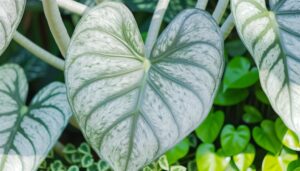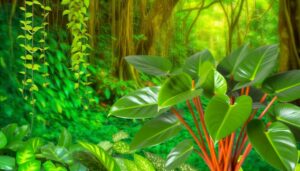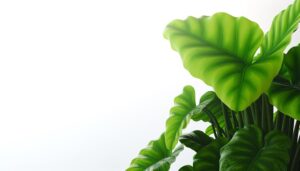What Are Some Interesting Facts About Philodendron Selloum?
Philodendron selloum, taxonomically identified as Thaumatophyllum bipinnatifidum, displays a monopodial climbing habit with large, deeply lobed leaves. As a member of the Araceae family, it develops adventitious roots for structural support and nutrient uptake.
This species demonstrates high efficacy in removing VOCs like formaldehyde and benzene, enhancing indoor air quality through significant stomatal conductance and transpiration rates. Peak growth occurs in bright, indirect sunlight with temperatures ranging between 65-80°F and humidity levels above 60%.
Susceptible to pests like spider mites and aphids, it thrives in well-draining, organic-rich soil. Further insights on its propagation and management await discovery.

Key Takeaways
- Philodendron selloum, also known as Thaumatophyllum bipinnatifidum, belongs to the Araceae family and has a monopodial climbing habit.
- It features large, deeply lobed leaves and adventitious roots that aid in its unique growth pattern.
- This plant excels in removing indoor air pollutants like formaldehyde and benzene through its metabolic processes.
- Optimal growth conditions include bright, indirect sunlight, temperatures between 65-80°F, and high humidity levels above 60%.
- Common pests include spider mites, aphids, and bacterial leaf spot, which can be managed through integrated pest management strategies.
Unique Growth Patterns
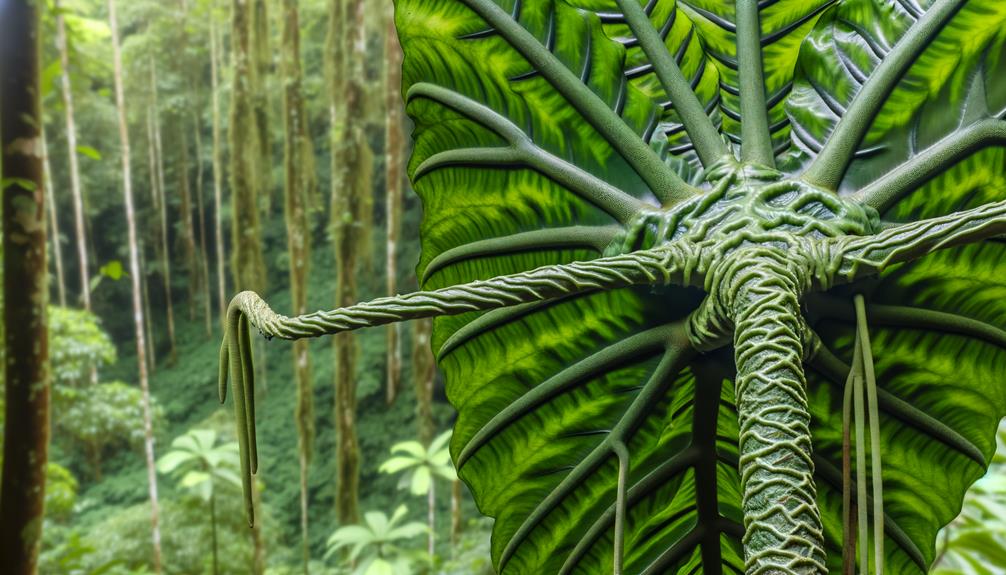
Philodendron selloum displays unique growth patterns characterized by its monopodial climbing habit and large, deeply lobed leaves that can reach up to one meter in length under ideal conditions.
This evergreen species, belonging to the Araceae family, demonstrates remarkable morphological adaptations, such as adventitious roots that facilitate its climbing ability. The species' stem elongates vertically, supporting the expansive foliage which contributes to its photosynthetic efficiency.
The deeply lobed leaves, scientifically referred to as pinnatifid, maximize surface area, optimizing light capture. Taxonomically identified as Thaumatophyllum bipinnatifidum in some classifications, this plant's growth is influenced by environmental parameters including humidity and light intensity.
Its robust, architectural form renders it a popular choice for both ornamental and ecological applications.
Air-Purifying Abilities
Renowned for its air-purifying capabilities, Thaumatophyllum bipinnatifidum efficiently removes volatile organic compounds (VOCs) such as formaldehyde and benzene from indoor environments, contributing to improved air quality.
This species, previously classified under the genus Philodendron, exhibits a remarkable ability to sequester harmful pollutants through its extensive leaf surface area and metabolic processes. Detailed studies have demonstrated that its stomatal conductance and transpiration rates play essential roles in the uptake and detoxification of airborne contaminants.
The plant's capacity to enhance indoor air quality is attributed to its physiological and morphological adaptations, including robust foliage and intricate vascular systems. Therefore, T. bipinnatifidum serves as an important component in bioremediation strategies and sustainable interior landscaping, promoting a healthier living space.
Ideal Growing Conditions
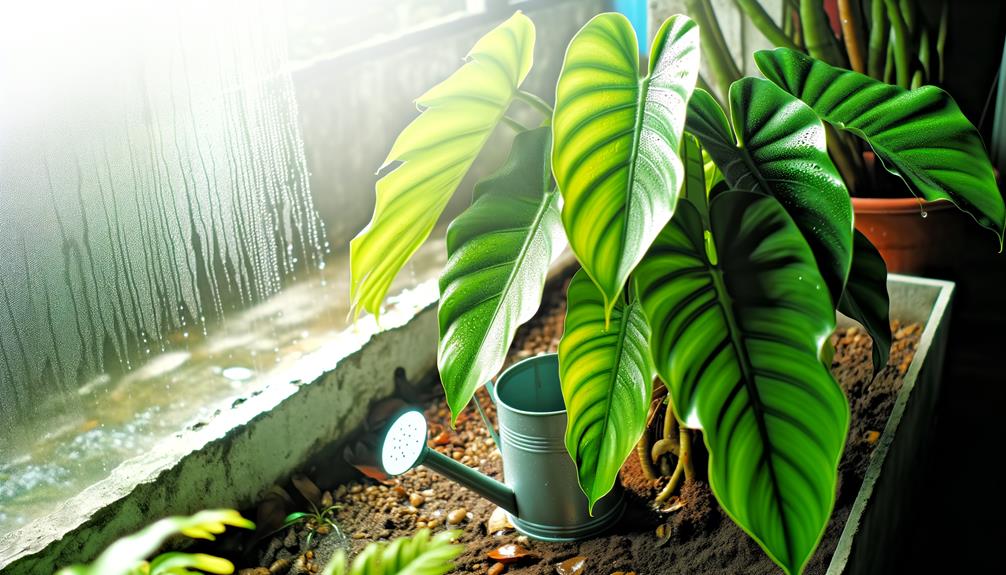
To fully harness the air-purifying benefits of Thaumatophyllum bipinnatifidum, it is crucial to understand its ideal growing conditions, which include specific light, temperature, and humidity requirements. This species, previously known as Philodendron selloum, thrives in environments that mimic its native tropical habitats.
- Light: Prefers bright, indirect sunlight, avoiding direct exposure which can cause foliar damage.
- Temperature: Best growth occurs between 65-80°F (18-27°C); temperatures below 50°F (10°C) can impede growth.
- Humidity: Needs high humidity levels, ideally above 60%, to replicate its natural environment.
- Soil: Well-draining, organic-rich soil supports root health and prevents waterlogging.
- Watering: Consistent moisture is necessary, but the root system must not remain submerged to avoid rot.
Attention to these conditions promotes robust growth and health.
Common Pests and Diseases
Thaumatophyllum bipinnatifidum, like many tropical plants, can be susceptible to a range of pests and diseases, including spider mites, aphids, and bacterial leaf spot, which may compromise its overall health and well-being.
Spider mites (Tetranychidae) often create fine webbing and cause stippling on leaves, leading to chlorosis. Aphids (Aphidoidea) secrete honeydew, promoting sooty mold growth. Bacterial leaf spot, caused by Xanthomonas campestris, manifests as water-soaked lesions that may coalesce and necrotize.
Management practices involve regular inspection, maintaining ideal humidity levels, and ensuring good air circulation. Implementing integrated pest management (IPM) strategies, such as biological controls and appropriate chemical treatments, can effectively mitigate these issues, safeguarding the plant's essentiality and aesthetic appeal.
Propagation Methods
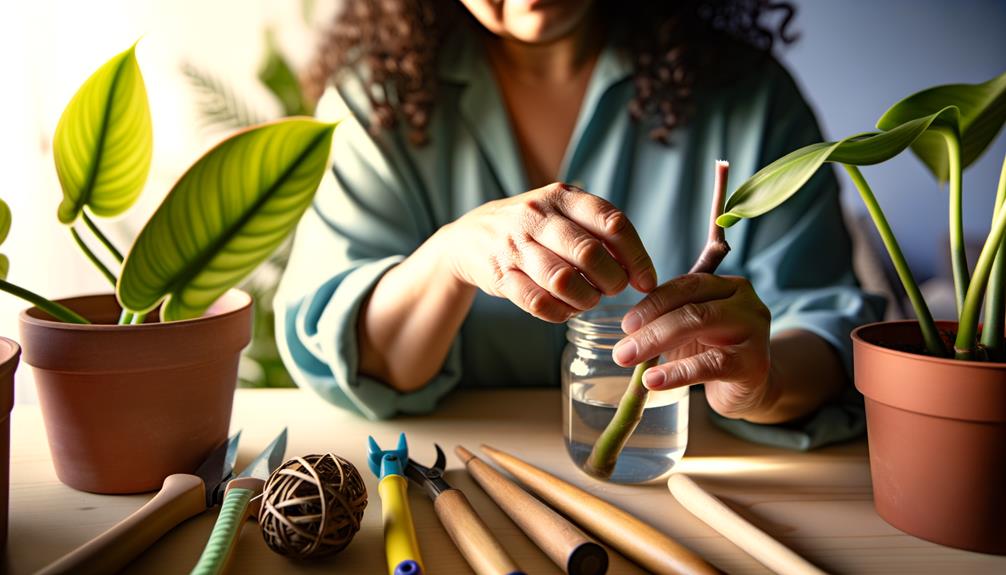
Propagation of Philodendron selloum, scientifically known as Thaumatophyllum bipinnatifidum, can be effectively achieved through asexual methods such as stem cuttings, air layering, and division. These methods guarantee genetic uniformity and are commonly employed in both horticulture and research settings.
Detailed observations and taxonomic references enumerate the following methods:
- Stem Cuttings: Sections of the stem are cut and rooted in a suitable medium.
- Air Layering: A stem section is wounded and wrapped in moist sphagnum moss until roots develop.
- Division: The plant is divided into smaller sections, each containing roots and shoots.
- Node Cuttings: Cuttings taken at the nodes where roots can easily form.
- Offshoots Removal: Offshoots or 'pups' are separated from the parent plant and potted individually.
These techniques facilitate efficient propagation, guaranteeing robust plant growth.
Conclusion
Philodendron selloum is a specimen of striking structure that showcases unique growth patterns and significant air-purifying abilities. This tropical plant thrives under specific conditions, necessitating appropriate light and humidity levels.
Despite its resilience, it remains susceptible to common pests and diseases requiring vigilant care. Propagation, primarily through stem cuttings, offers a feasible method for cultivation.
This fascinating flora, with its formidable foliage, continues to captivate botanists and horticulturists alike, underscoring its enduring appeal and ecological importance.




